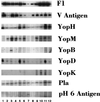Immune response to Yersinia outer proteins and other Yersinia pestis antigens after experimental plague infection in mice
- PMID: 10085037
- PMCID: PMC96547
- DOI: 10.1128/IAI.67.4.1922-1928.1999
Immune response to Yersinia outer proteins and other Yersinia pestis antigens after experimental plague infection in mice
Abstract
There is limited information concerning the nature and extent of the immune response to the virulence determinants of Yersinia pestis during the course of plague infection. In this study, we evaluated the humoral immune response of mice that survived lethal Y. pestis aerosol challenge after antibiotic treatment. Such a model may replicate the clinical situation in humans and indicate which virulence determinants are expressed in vivo. Immunoglobulin G enzyme-linked immunosorbent assay and immunoblotting were performed by using purified, recombinant antigens including F1, V antigen, YpkA, YopH, YopM, YopB, YopD, YopN, YopE, YopK, plasminogen activator protease (Pla), and pH 6 antigen as well as purified lipopolysaccharide. The major antigens recognized by murine convalescent sera were F1, V antigen, YopH, YopM, YopD, and Pla. Early treatment with antibiotics tended to reduce the immune response and differences between antibiotic treatment regimens were noted. These results may indicate that only some virulence factors are expressed and/or immunogenic during infection. This information may prove useful for selecting potential vaccine candidates and for developing improved serologic diagnostic assays.
Figures


References
-
- Alaparthy S, Barrett J F. Abstracts of the 97th General Meeting of the American Society for Microbiology 1997. Washington, D.C: American Society for Microbiology; 1997. Superinduction of IL-12 p40 gene expression by fluoroquinolones and its regulation of the Th1 cytokine profiles, abstr. E-2.
-
- Andrews, G. P., S. T. Strachan, G. E. Benner, A. K. Sample, J. J. Adamovicz, G. W. Anderson, Jr., S. L. Welkos, and A. M. Friedlander. Unpublished observations.
MeSH terms
Substances
LinkOut - more resources
Full Text Sources
Other Literature Sources
Medical

